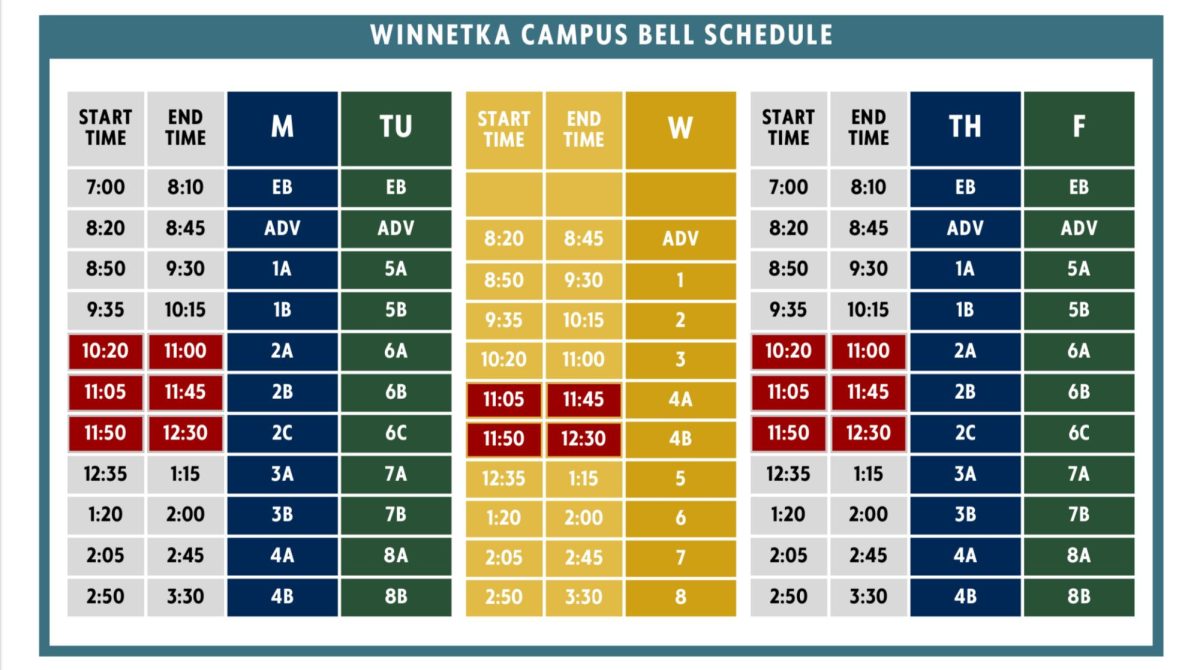“80 minutes! That’s longer than some of my college classes,” my older brother said. It was the summer before my freshman year, and we were discussing New Trier’s schedule changes.
I have to say that at the time, I agreed with him. The thought of a Spanish class that was over an hour haunted me each night leading up to the first day of school. However, after a year and a half of experience with the block schedule, I am shocked at how wrong I was. As it turns out, I have grown to become a fierce defender of the block schedule. There are a lot of people against New Trier’s current schedule, but there are so many reasons why the nine-period day is inferior, and why getting rid of green and blue days would be a great disservice to students.
First of all, the 80-minute periods do not feel as long as one might expect. The passing periods help to break up each class, and honestly, what dictates how long a class feels is the content, not how much time it is in reality. Sure, 80 minutes of an inherently boring class may seem to drag on forever, but with the block schedule, you won’t have to attend that class again for two days. Besides, if the class is interesting, I find that the longer amount of time helps me get more engrossed in my work, which leads to the period flying by. I also get far more done in my classes on blue and green days when compared to anchor days.
Another advantage of blue and green days is that students only have four classes each day. On days when I am running on insufficient amounts of sleep, knowing I only have to deal with half of my classes can be a great motivator. Also, many students find that their favorite classes are grouped into one day, which gives them something to look forward to (e.g., “it’s a Monday, but at least I have my better schedule today”).
Perhaps the best aspect of the block schedule is that it means school days are different. A few months ago, we had two anchor days in a row, and since then, I have found a new appreciation for our somewhat unconventional schedule. Walking into school knowing the day will not be the exact same as the last helps break up the monotone, repetitive cycle school can sometimes feel trapped in. Having three schedules adds much more variety to the school week.
Still, each Monday is a blue day, each Tuesday is a green day, Wednesdays are anchor days, and so on, so there remains a good amount of uniformity at New Trier. It is my understanding that before New Trier incorporated anchor days, there was a lot of confusion on what color each day would be, but now that no longer feels like an issue—especially with things like the NT block app.
In 2020, the New Trier News wrote an article about teacher and student opinions on the new block schedule. In this article, they cover some of the aforementioned benefits, but also many of the common critiques. What is interesting is that almost all the complaints involved Zoom. Teachers reported that the hybrid schedule was confusing, as they were unsure when they were supposed to hold Zoom meetings, and students felt 70-minute long Zoom classes were impractical and painful. These issues are completely irrelevant now. The fact that the main concerns with the block schedule were related to Zoom—which is something we no longer use at school—further reinforces that it is currently the best scheduling option.
The block schedule makes for a better time at school. Despite how scared I was for 80-minute periods, I enjoy all my longer classes for the most part. The block schedule leads to far more productivity, it means there is more variety in the school week, and it makes the day go by faster, making it the clear winner over the traditional bell schedule.






































